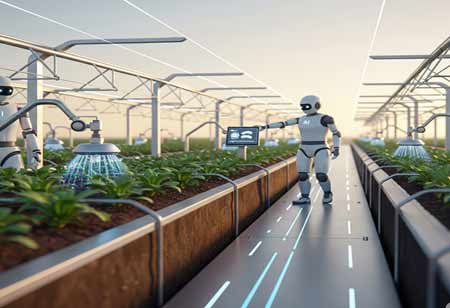Thank you for Subscribing to Agri Business Review Weekly Brief
Smart Farming Revolution: The Impact of AI on Agriculture
AI is transforming agriculture through precision farming, automated equipment, and enhanced livestock management, leading to more sustainable practices and improved food production efficiency.

By
Agri Business Review | Thursday, June 19, 2025
Stay ahead of the industry with exclusive feature stories on the top companies, expert insights and the latest news delivered straight to your inbox. Subscribe today.
The agricultural landscape is driven by the pervasive integration of Artificial Intelligence (AI). From the microscopic world of soil nutrients to the vast expanse of global supply chains, AI is redefining the way food is produced, enabling unprecedented levels of precision, efficiency, and sustainability. This technological revolution is not merely an incremental improvement but a fundamental shift towards truly intelligent cultivation, where data-driven insights and autonomous capabilities are becoming the norm.
The Role of AI in Precision Farming
At its core, AI in agriculture leverages sophisticated algorithms and machine learning models to analyze vast datasets, enabling proactive and optimized decision-making across the entire farming lifecycle. This data originates from a multitude of sources, including advanced sensors deployed in fields, high-resolution satellite imagery, drone-captured visuals, and historical weather patterns. The ability of AI to process and interpret this complex information in real-time empowers cultivators to transition from reactive responses to predictive management strategies.
One of the most significant areas of AI's impact is in precision farming. This paradigm optimizes resource utilization by applying inputs like water, fertilizers, and pesticides precisely where and when they are needed. AI-powered systems analyze real-time data on soil moisture, nutrient levels, and crop health to create highly detailed maps and recommendations. This targeted approach not only enhances yields but also significantly reduces the wastage of valuable resources, leading to more environmentally sound practices. The economic benefits are substantial, with studies indicating significant reductions in water and energy consumption, as well as improved crop productivity.
AI has revolutionized crop monitoring and yield prediction. Machine learning models, fed with historical yield data, current crop conditions, and environmental factors, can forecast yields with remarkable accuracy. This predictive capability enables better resource planning, inventory management, and even informed market positioning. Furthermore, AI algorithms analyzing multispectral images from drones and satellites can detect early signs of crop stress, disease outbreaks, or nutrient deficiencies, often before they are visible to the human eye. This early warning system enables timely interventions, thereby safeguarding yields and minimizing crop losses.
Advancements in Automated Farming Equipment
Automated farming equipment is another rapidly advancing frontier. Self-driving tractors, robotic sprayers, and autonomous harvesters are ushering in a new era of efficiency in agricultural operations. These machines, equipped with AI and sensor data, perform tasks such as planting, weeding, and harvesting with minimal human intervention. Advanced vision systems enable these robotic tools to differentiate between crops and weeds, allowing for precision herbicide application and reducing chemical usage. The development of "green-on-green" spraying technology, which can specifically identify weeds within growing crops, promises further reductions in chemical input.
Enhancing Livestock Management with AI
Beyond field operations, AI is having a significant impact on livestock management. AI-powered systems support real-time monitoring of animal health, behavior, and welfare. Sensors and cameras collect data that, when analyzed by machine learning algorithms, can identify early signs of illness, stress, or discomfort. This enables personalized care and prompt intervention, contributing to improved animal well-being and productivity. AI also plays a role in optimizing feed management by tailoring nutrition to individual animal needs, thereby reducing waste and enhancing efficiency. Predictive analytics for disease outbreaks further strengthens animal health management.
The integration of AI extends to supply chain optimization within agriculture. AI-powered predictive analytics are transforming logistics by improving inventory management and demand forecasting. By analyzing historical market trends and anticipating disruptions, AI helps to limit waste, enhance organization, and ensure timely delivery of produce from farm to fork. Route optimization for transportation further contributes to efficiency and reduced emissions.
Interplay of various technologies characterizes the current state of AI-powered agriculture. The Internet of Things (IoT) provides the critical data backbone, with countless interconnected sensors gathering information from every corner of the farm. Cloud computing platforms enable the storage and processing of these massive datasets, while advanced analytics and machine learning algorithms extract actionable insights from them. The development of edge computing is also gaining traction, allowing AI models to run on local devices, enabling real-time decision-making even in areas with limited internet connectivity.
The industry is witnessing continuous advancements in AI models, becoming more accurate and capable of analyzing an even broader range of data inputs. This leads to increasingly precise recommendations and autonomous capabilities. The push towards sustainable farming practices has significantly accelerated the adoption of AI globally, as these technologies inherently support reduced resource consumption and environmental impact. Governments and research initiatives are increasingly investing in smart farming programs and rural digital infrastructure to facilitate the widespread adoption of these technologies. However, the role of policymakers and technology enthusiasts is also crucial in advocating for the benefits of AI in agriculture and promoting its responsible and equitable implementation.
AI is ushering in an era of intelligent agriculture, where data, automation, and predictive capabilities are converging to create more productive, resilient, and sustainable food systems for a growing global population. The trajectory of innovation points towards even greater autonomy, enhanced decision support, and a deeper understanding of complex agro-ecosystems, fundamentally reshaping the future of food production.





